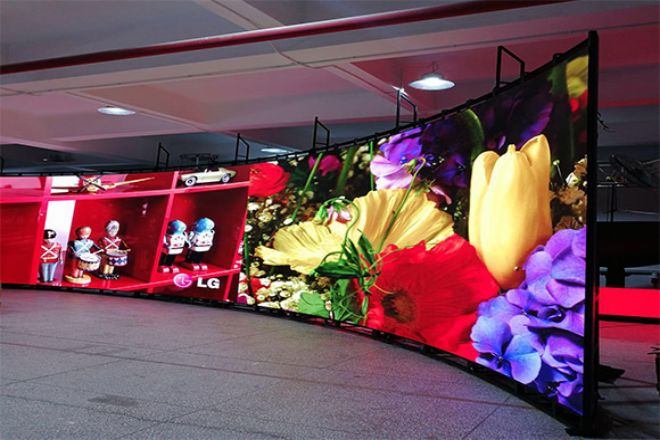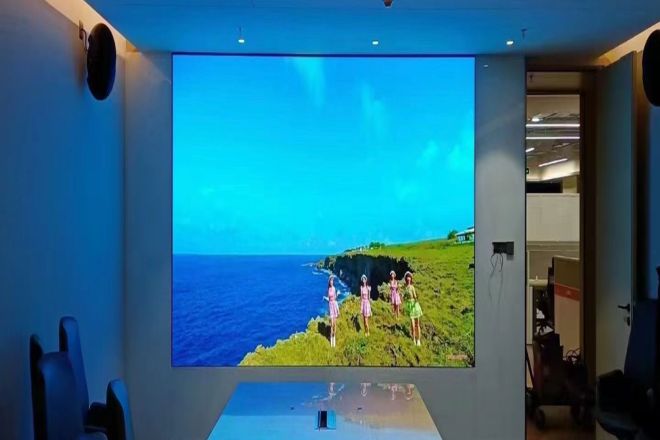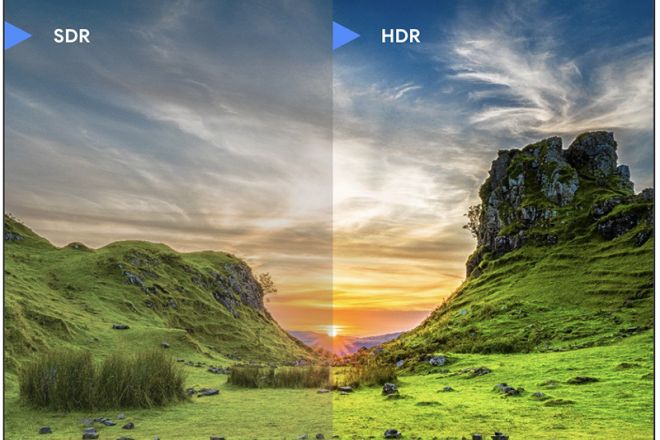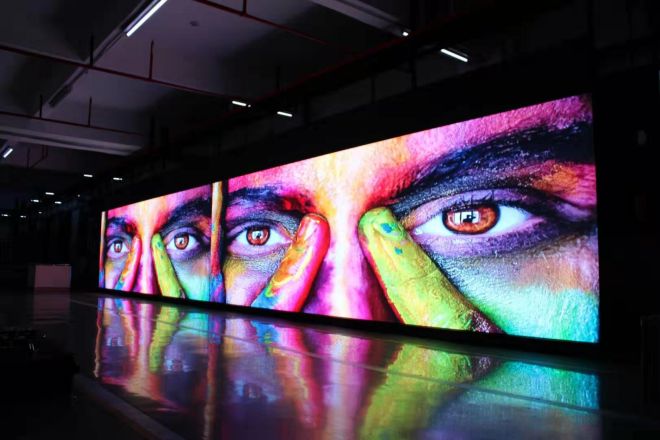Introducción

Con el rápido desarrollo de la tecnología, pantallas de visualización LED Se han utilizado ampliamente en diversas ocasiones gracias a sus ventajas, como su alto brillo, larga vida útil y amplia aplicabilidad. Ya sea en grandes vallas publicitarias exteriores, eventos deportivos en vivo, exhibiciones comerciales o comunicados de prensa en salas de conferencias, las pantallas LED se han convertido en dispositivos de visualización indispensables gracias a su excelente rendimiento.
En este proceso de desarrollo, la búsqueda de efectos de visualización no ha cesado. La tecnología HDR (alto rango dinámico), una de las que ha atraído gran atención en el sector de las pantallas en los últimos años, ofrece un rango de brillo más amplio y un mayor contraste, brindando a los usuarios una experiencia visual más realista y natural. Entonces, ¿pueden las pantallas LED ofrecer efectos de visualización HDR?
1. Descripción general de la tecnología de pantalla LED

Una pantalla LED es un dispositivo de visualización que utiliza diodos emisores de luz (LED) como elementos de visualización. Las pantallas LED aprovechan esta característica para mostrar diversas imágenes y textos controlando la corriente de los LED en diferentes puntos de píxel.
1) Principales tipos de pantallas LED
Existen muchos tipos de pantallas LED y las más utilizadas incluyen:
Pantalla LED a todo color: Puede mostrar varios colores y se utiliza principalmente en publicidad interior y exterior. Actualmente es el tipo más común.
Pantalla LED monocromática: generalmente solo muestra un color (como el rojo) y se utiliza principalmente para mostrar texto y otros lemas, como letreros de tiendas al aire libre, pantallas de visualización de información, etc.
Pantalla LED de dos colores: generalmente rojo y verde, también se utiliza para visualización en pantalla de tira, principalmente en interiores.
Pantalla LED curva:generalmente compuesto por módulos suaves flexibles o realizado mediante empalme giratorio con módulos LED convencionales, mayormente utilizados en ocasiones publicitarias.
Pantalla LED transparente:Incluye tecnología de pantalla de rejilla transparente y pantalla de película de cristal, puede lograr un efecto de visualización translúcido.
2) Las características de la pantalla LED incluyen el rendimiento del color, el brillo, el contraste, etc.
Rendimiento del color: La pantalla LED adopta un sistema avanzado de gestión del color, que puede restaurar con precisión la información del color en la imagen o el video original, presentando un efecto de color real y natural.
Brillo: El brillo de una pantalla LED se expresa generalmente en intensidad luminosa (Intensidad Luminosa), cuya unidad es la candela (cd). El brillo de las pantallas LED para uso en interiores y exteriores varía para adaptarse a diferentes entornos de iluminación.
Contraste: El contraste es la diferencia de brillo entre las partes más brillantes y más oscuras de la pantalla. El contraste de las pantallas LED se ve afectado por el brillo de las bombillas LED, la capacidad de reproducción del color y la luz ambiental. Las pantallas LED de alto contraste pueden reproducir mejor los colores del mundo real y ofrecer efectos visuales más vívidos.
2. Análisis del efecto de visualización HDR
1) Definición y principio de funcionamiento del HDR
HDR, cuyo nombre completo es Alto Rango Dinámico (HDR). La tecnología HDR es una tecnología de procesamiento de imágenes que busca mejorar el rango de brillo de una imagen para que esta muestre mejor las luces brillantes y los detalles oscuros.
Su principio de funcionamiento se basa en la percepción del brillo por parte del ojo humano; es decir, el ojo humano puede adaptarse tanto a entornos oscuros como a entornos con mucha luz y distinguir detalles con gran riqueza de detalles. Sin embargo, debido a las limitaciones de los sensores y pantallas de las cámaras, las imágenes convencionales no pueden capturar ni mostrar completamente este amplio rango de brillo.
La tecnología HDR permite que las imágenes muestren un rango de brillo más amplio y detalles más ricos a través de la fusión de imágenes y la optimización de múltiples exposiciones.
2) El papel del HDR en la mejora de la calidad de la imagen
La tecnología HDR juega un papel importante en la mejora de la calidad de la imagen, lo que se refleja principalmente en los siguientes aspectos:
Negro más profundo: la tecnología HDR puede proporcionar un rango de brillo más amplio, lo que permite que las áreas negras muestren niveles y detalles más profundos, evitando el fenómeno de “aplastamiento” que puede ocurrir en las áreas negras en la tecnología de visualización tradicional.
Blanco más brillante: la tecnología HDR puede mostrar áreas blancas más brillantes, lo que hace que los reflejos sean más realistas y naturales, evitando la sensación de “descolorido” que puede aparecer en las áreas blancas de la tecnología de visualización tradicional.
Colores más ricos: la tecnología HDR puede restaurar con mayor precisión la información de color en la imagen, haciendo que el color de la imagen sea más vívido y rico y mejorando el efecto visual general de la imagen.
3) Estado actual de la aplicación de la tecnología HDR en diferentes dispositivos de visualización.
La tecnología HDR se ha utilizado ampliamente en diversos dispositivos de visualización, incluidos televisores, proyectores, monitores, etc.:
TV: La tecnología HDR se ha convertido en un estándar en los televisores de alta gama, ofreciendo a los usuarios una experiencia visual más realista y nítida. Gracias al continuo desarrollo tecnológico, el rendimiento de los televisores HDR también mejora constantemente, con la incorporación de una mayor resolución y una gama cromática más amplia.
Proyector: La tecnología HDR también se utiliza en el campo de los proyectores, lo que hace que la imagen proyectada sea más clara y brillante y adecuada para las necesidades de proyección en diversas ocasiones.
Pantalla: Las pantallas HDR ofrecen un rango de brillo más amplio y colores más intensos, lo que permite a usuarios profesionales, como diseñadores y fotógrafos, visualizar y editar imágenes y vídeos con mayor precisión. Además, las pantallas HDR se están utilizando gradualmente en ordenadores y consolas de videojuegos para el usuario doméstico.
3. ¿Cuál es la diferencia entre HRD y SDR?

HDR (alto rango dinámico) y SDR (rango dinámico estándar) difieren significativamente en varios aspectos:
- Definición conceptual:
HDR se refiere a imágenes de alto rango dinámico, que pueden capturar, procesar y reproducir contenido para aumentar los detalles de las sombras y las luces de la escena.
SDR es un estándar de vídeo utilizado desde los monitores CRT. Es un estándar general para pantallas de vídeo y cine, que utiliza señales de curva gamma tradicionales para describir imágenes o vídeos.
- Rendimiento del detalle de la imagen:
El HDR permite obtener imágenes con mayor detalle entre la luz y la oscuridad. Por ejemplo, al fotografiar una bombilla, la imagen HDR puede mostrar la escena normal alrededor de la bombilla en relación con la habitación oscura, lograr una mayor tolerancia y mostrar la intensidad de la luz emitida por bombillas de diferente brillo.
SDR obtiene más detalles de imagen bajo la misma imagen.
- Rango de brillo:
HDR tiene un rango de brillo más amplio, permitiendo un brillo superior a 1000 nits y un brillo inferior a 1 nit.
SDR puede generar 100 nits.
- Gama de colores:
El HDR utiliza un espacio de color significativamente mayor que el SDR. El HDR suele utilizar la gama de color P3 o incluso Rec. 2020, mientras que el SDR suele utilizar Rec. 709.
- Profundidad de color:
HDR puede tener una profundidad de color de 8 bits, 10 bits y 12 bits.
SDR normalmente tiene una profundidad de color de 8 bits.
- Escenarios de aplicación:
La mejora en la calidad de imagen que aporta la tecnología HDR es intuitiva y se ha introducido ampliamente en películas, vídeos e incluso juegos.
SDR sigue siendo el formato predeterminado utilizado en televisores, monitores y proyectores, y la gran mayoría del contenido de video, ya sean juegos, películas o videos en línea, todavía utiliza SDR.
- Detalles técnicos:
HDR utiliza metadatos dinámicos para cambiar la información enviada al televisor en función de cada escena para que el televisor pueda mostrar correctamente el contenido con su nivel de brillo correcto.
Cabe destacar que, si bien el HDR ofrece ventajas técnicas, no todos los televisores pueden demostrar plenamente sus ventajas. Para obtener una buena calidad de imagen HDR, el televisor debe contar con características como alto contraste y una amplia gama cromática.
Finalmente, cabe destacar que la diferencia entre HDR y SDR no se limita a los puntos anteriores, sino que también puede incluir otros detalles y parámetros técnicos. Al elegir entre HDR o SDR, es necesario realizar consideraciones exhaustivas según los escenarios y necesidades de aplicación específicos.
4. Tendencia de desarrollo de la tecnología HDR para pantallas LED

1) El impacto del progreso tecnológico en el efecto HDR de la pantalla LED
Con el continuo avance tecnológico, el efecto HDR de las pantallas LED también mejora continuamente. El alto brillo y el alto contraste de las pantallas LED, combinados con la tecnología HDR, han mejorado significativamente el contraste, la riqueza de color y la presentación de detalles de la pantalla.
Además, la aplicación de nuevos circuitos integrados de controlador, un control de escala de grises más preciso y una tecnología de gestión del color también brindan un fuerte apoyo para la mejora de los efectos HDR en las pantallas LED.
2) Dirección futura del desarrollo de la tecnología HDR para pantallas LED
- Resolución más alta:
Con el continuo desarrollo tecnológico, la densidad de píxeles de las pantallas LED aumentará aún más y su resolución será cada vez mayor. Esto permitirá que las pantallas LED presenten imágenes más nítidas y definidas al mostrar contenido HDR.
- Gama de colores más amplia:
En el futuro, las pantallas LED adoptarán una tecnología de gestión del color más avanzada y una gama cromática más amplia para una mejor compatibilidad con el contenido HDR. Esto permitirá que la pantalla alcance una mayor riqueza y precisión cromática.
- Tecnología de visualización más inteligente:
En el futuro, las pantallas LED integrarán funciones más inteligentes, como corrección de color inteligente, ajuste de brillo inteligente, etc. Estas funciones permitirán que las pantallas LED ajusten automáticamente el efecto de visualización de acuerdo con diferentes escenas y contenido al mostrar contenido HDR, proporcionando así una experiencia visual más realista y natural.
- Pantalla flexible:
Las pantallas LED flexibles se pueden doblar libremente según sea necesario, lo que facilita su uso en lugares especiales y con poca iluminación. Además, la tecnología de pantallas flexibles ofrece más posibilidades para el efecto HDR de las pantallas LED.
- Bajo consumo energético y fuerte interactividad:
Las futuras pantallas LED priorizarán el ahorro energético y la interactividad. Al adoptar tecnología avanzada de ahorro energético y mejorar las funciones interactivas, como la pantalla táctil y el reconocimiento de gestos, las pantallas LED podrán reducir el consumo energético y mejorar la experiencia del usuario, garantizando al mismo tiempo un excelente rendimiento de visualización.
3) Perspectivas de aplicación de la tecnología HDR de pantallas LED en diversas industrias
La tecnología HDR de las pantallas LED se utilizará ampliamente en diversas industrias. En el sector publicitario, la tecnología HDR hará que las imágenes publicitarias sean más vívidas y realistas, atrayendo más atención.
En lugares de entretenimiento como cines y teatros, la tecnología HDR proporcionará una experiencia de visualización más realista e impactante; en lugares de eventos a gran escala, como estadios y centros de conferencias, la tecnología HDR hará que las transmisiones en vivo y las retransmisiones sean más claras y fluidas.
En el transporte, la atención médica, la seguridad y otros campos, la tecnología HDR también desempeñará un papel importante en la mejora del efecto y la eficiencia de la monitorización y la visualización. En resumen, la tecnología de pantallas LED HDR brindará a los usuarios una experiencia visual más avanzada y completa, y desempeñará un papel fundamental en muchas industrias.
Conclusión
Tras un análisis exhaustivo de las pantallas LED y la tecnología HDR, podemos concluir que las pantallas LED sí pueden ofrecer efectos HDR. Gracias a la adopción de tecnología de visualización avanzada y algoritmos de optimización, las pantallas LED pueden alcanzar el amplio rango de brillo y el alto contraste que requiere la tecnología HDR, ofreciendo a los usuarios una experiencia visual más realista y natural.
Por último, si quieres saber más sobre las pantallas LED, Por favor póngase en contacto con nosotros.
